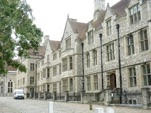
Very noisy teaching machines providing programmed learning were introduced by some schools, but they suffered from poor quality teaching material.
All that disappeared with the advent of the personal computer. Computers became a tool rather than just an object for study. A government scheme enabled us to buy low-cost personal computers of which the BBC Micro was the most popular and soon every secondary school had one and not long afterwards primary schools as well. By the time I left there were roomfuls of them.
Then came the Internet — in embryonic form to start with. Hampshire was the first county in the UK to install computers connected to TimesNet, a network search engine provided by the newspaper for free to all secondary schools in the country that had the equipment. Pioneering days.
A Tory MP from Havant, allegedly anxious to get a knighthood, persuaded the Board of Trade to give a few million pounds to the 4 secondary schools in the borough in return for their enhancing the use of computers. Over several months I had to chair frantic planning meetings of the 4 head teachers and local advisers with the MP in watchful attendance.
Once the money had duly arrived he suggested we should have a grand launch of the Havant Project, and wouldn’t it be a good idea if the Prime Minister (Margaret Thatcher) came to open it. On the big day dozens of students each with a pc were installed in the unfamiliar (to them) local FE college and awaited the arrival of the formidable lady. After she had been greeted by the big wigs below I awaited her arrival upstairs and accompanied her, with the MP ever present, as we walked round the spaces where the students were sitting supposedly working on machines that had only arrived a week or so beforehand.
Rather to my surprise she spent more time than was expected chatting with the students and overstaying her schedule by almost an hour. At one point she said, “This is what it’s all about — all these young people using computers. In a few years we’ll cut down unemployment to near zero”. Before I could say a word the MP unwisely (but correctly) said, “With due respect, Prime Minister, it’s not as simple as that”. “Not as simple as that, Ian?”, she retorted quite violently, “Of course it’s as simple as that!” End of conversation. No chance of a knighthood after that.
As we approached the room where she was about to make a speech, she asked me if her hair was in a mess. It’s just fine, I said. Would I have dared say anything else?
One friday afternoon the Assistant Education Officer called me in. ‘I have a problem’ he said, ‘allocating staff to all these secondary schools. Normally I just apply a teacher/pupil ratio across the board. But heads of the smaller schools don’t like it. They keep asking for more. I want you to let me have a system that is fair for all. By Monday morning first thing if you would?’
Fortunately I’d recently attended a course on staffing. Simply put, a school with say 160 pupils in the first year needs the same number of teachers for that year as a school with180 pupils — if the size of each form is not to be larger than 30, ie a 6-form entry school. In the upper classes a small school needs proportionately more teachers than a large school in order to offer a reasonable range of GCSE options.
The same teacher/pupil ratio for both is indeed unfair.
Drugged with pints of strong coffee and working until the early hours over the weekend I produced several sheets of A3 hand-written tables showing the teacher requirement year by year for any size of school in increments of 10 pupils per year group, duly handed over on Monday morning. It turned out that the proper ratios ranged from under 16:! to over 20:1.
Years after I’d retired I was quite chuffed when a head teacher said to me at a party that they still used the Bothwell Tables when calculating staffing needs. The nearest I’ll get to immortality, for sure.

What! A Castle? Hardly, but it is so named because it was built on a mediaeval fort the remnants of which are on show nearby. This somewhat bleak and soulless Victorian building that housed the hub of Hampshire Education was my base for 13 years from 1974.
Vying with Kent and Yorkshire to be the largest Authority in the UK, much of the day-to-day admin was devolved to 8 area offices with their own education and advisory officers, each of them with a teachers’ centre.
However the main (very large) advisory team based in Winchester controlled a generous budget for curriculum development, and we were serviced by an team of excellent support staff.

Local Government: Hampshire 1974-89
The Castle, Winchester


All this reinforces the importance of pastoral care in secondary schools especially during the yearly years, and I was glad to have the chance to chair a group that produced an aide memoire to secondary schools.
What did this senior advisory officer for secondary education get up to apart from that? Well, shortlisting applications for headships and attending the interviews; advising on staffing levels for around 100 individual schools; meetings with architects of new buildings, arranging/running in-service courses for head teachers, visiting schools and colleges as often as possible, umpteen meetings with colleagues, all these were the nuts and bolts of the job. I also had responsibility for computer education and from time to time there were cases of failing schools or under-performing teachers that demanded urgent attention. Variety aplenty.
Our payslips stipulated 37 hours a week. it was rare not to exceed 50 hours excluding residential weekend courses and papers that had to be worked on at home. Never any paid overtime. Mind you, there were compensations. It was up to us whether to turn up at the office during school holidays for example, although we frequently did.
In a vain attempt to avoid having to bring in a national curriculum the Department of Education invited authorities to persuade secondary schools to rebalance their priorities — TVEI (Technical Vocational and Educational Initiative). In consultation with Heads I prepared a scheme which was accepted. I then applied for the job of Director of TVEI and in was in that capacity that I spent my final two years, virtually independent of the local authority. Rather nice.
I cannot remember any time being bored; mostly it was enjoyable and fulfilling working with a great team. Some of us (those still alive!) regularly meet up, still in 2014, as the ‘old devils’ for a pub lunch to share nostalgic memories and put the world to rights. We were fifteen or more at one time. Now just six of us.
Teacher/Pupil Ratios
Computers
glimpses of my life and thoughts
Retirement
I was determined not to allow the system to decide my departure date at the statutory age of 65, so I gave ample notice that I intended to leave a year ahead, in 1989. A number of farewells were staged to ensure I didn’t change my mind! I bid goodbye to the support staff and made my final journey home from work in Winchester. Any sadness that I felt quickly vanished on my arrival. As Anne and I entered the living room there was a great cheering as all the members of our extended family rose up from behind chairs and sofas where they’d been hiding. It was a total surprise, among the most emotional and pleasurable moments of my life.
See post retirement for my musings on what happened next.
